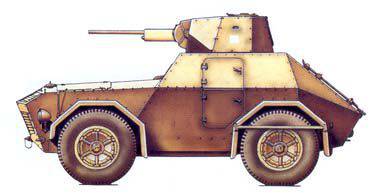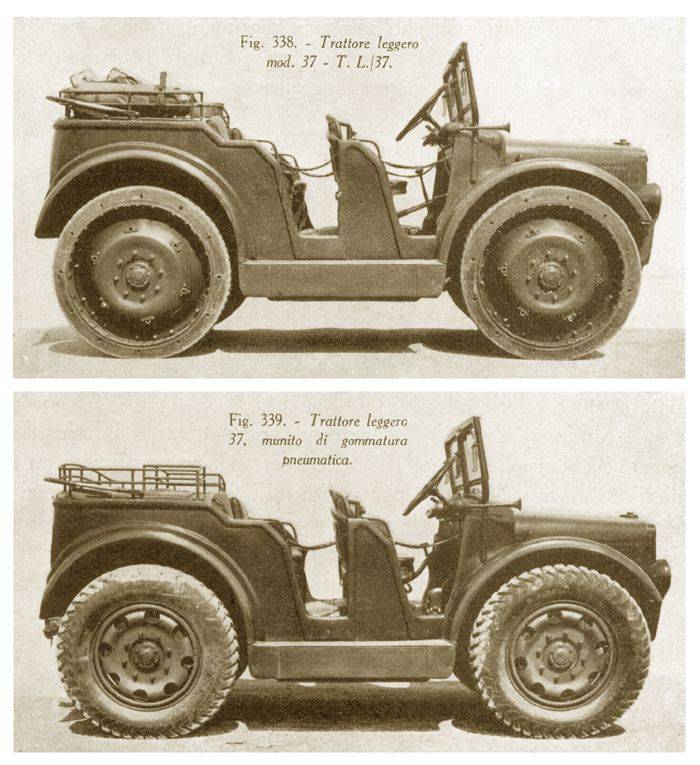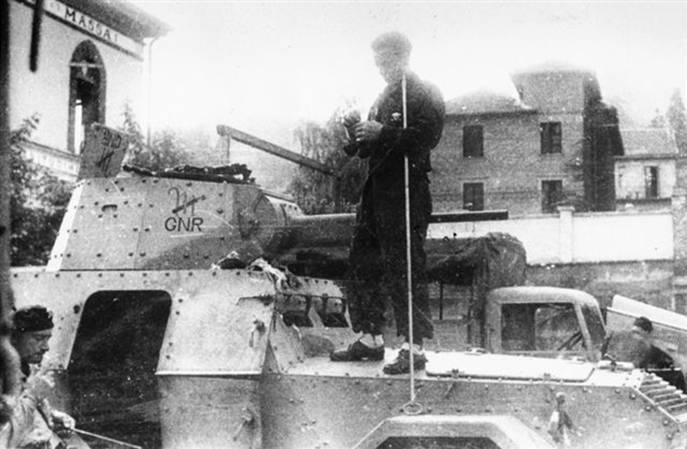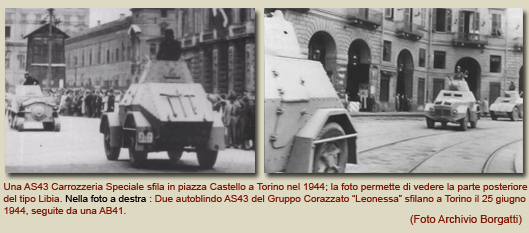Armored car SPA-Viberti AS43 (Italy)
Write-off of outdated equipment in combination with combat losses dealt a serious blow to the fleet of Italian armored cars. From 1941, the command began to pay special attention to the most simple projects of this kind of technology, which did not differ in a large number of bold innovations. It was necessary to simplify the design of machines in order to speedily deploy their production. All developments that did not correspond to such an ideology were rejected and did not reach mass production. In particular, for these reasons it was necessary to develop new armored cars based on the existing technology.
Throughout the African campaign, Italian troops actively used light artillery FIAT-SPA TL37. This all-wheel drive vehicle had high enough characteristics and coped well with the tasks assigned to it for the transportation of artillery guns. According to some data, already in 1941, the enthusiasts from the military units began to attempt to install on the booking tractors. In addition, there were proposals to install light artillery on such machines. Nevertheless, full-fledged work on the alteration of the TL37 tractor into a combat vehicle started a little later.

General scheme of the SPA-Viberti AS43 machine. Figure Aviarmor.net
Due to certain reasons directly related to wartime problems, the development of the design of an armored vehicle based on the TL37 tractor was seriously delayed. The decision to create such a combat vehicle was made only in 1942 year. The next few months, Viberti specialists engaged in various design works, but did not manage to complete their work before the capitulation of Italy. Soon, however, work resumed. Now the design was carried out in the interests of the Italian Social Republic and was carried out with some assistance from German engineers.
According to the names of the companies that developed the chassis and the overall design of the armored car, the new car received the designation SPA-Viberti AS43. The number "43" denotes the proposed adoption year. In fact, the first production armored cars of the new model left the assembly line only in 1944 year.
The FIAT-SPA TL37 light artillery tractor was put into service in the 1938 year and soon became one of the main means of towing various types of guns. This car had a number of important advantages, in particular, the 4x4 wheel formula provided high throughput with and without towed cargo. In addition, all four wheels were made manageable, which facilitated maneuvering and had a positive effect on the performance of some basic tasks. In addition, TL37 tractors were mass-produced and were well mastered in production.
In appearance and overall layout, the TL37 was like a jeep. He had a bonnet layout, an open cockpit without doors, a driver's seat and several gunners. In the rear of the hull a volume was provided for the transport of ammunition or other cargo weighing up to 250 kg. The tractor was equipped with a FIAT 18T1 petrol engine with an 52 horsepower, coupled with a manual transmission. Such a power plant made it possible to reach speeds up to 38 km / h and move the payload (in the body and in tow) with a total weight of up to 800 kg. The front axle was equipped with a spring suspension. Rear, which accounted for the main load, was attached to the leaf springs.
Such a massive chassis, despite the relatively low maximum speed, could be a good base for a promising armored car. In addition, over time, the developers of the AS43 project simply had no choice: after the capitulation of Italy to the newly formed Italian social republic, mass military equipment was urgently needed. In such conditions, it was possible to come to terms with the insufficient characteristics of new developments, since at the head of the corner were the speed of deployment of production and its mass character.

Various modifications artillery tractor FIAT-SPA TL37. Photo of Wikimedia Commons
It was proposed to mount a new armored body on the base chassis. In view of the difficulties with the production of technology, the new project implied the extensive use of existing components. Thus, the armored hull of the AS43 armored car was a revised unit of the FIAT-SPA S37 armored personnel carrier, and weapon should have been placed in a turret borrowed from the lung tank L6 / 40 and already used on armored cars of the AB40 family.
The armored hull of the SPA-Viberti AS43 was divided into two main compartments. In the front, which had a smaller size, was located the engine and some transmission units. The rear compartment was a combined combat compartment and a control compartment. The entire crew and all weapons were located exactly in this volume. The armor case was proposed to be assembled from a large number of sheets of different shapes, which were fastened to the frame with the help of rivets.
The engine compartment had straight vertical sides, a curved roof of two sheets and a wedge-shaped forehead. Upper and lower frontal parts had unregulated louvers for air access to the radiator and ventilation of the compartment. In the upper sheets were provided hatch covers for servicing the engine. In the sides of the front of the hull had to provide large recesses, in which the wheels were located. In addition, the wings protruded beyond the hull, covering the wheels from bullets and fragments.
The habitable compartment of the hull was assembled from several armor plates installed at different angles to the vertical. In this case, the lower sheets were mounted with the collapse outward, and the upper, in turn, were tilted inward. Both sides and hull feeds had such an angular shape. In the rear of the sides there were grooves for the wheels and large wings. On the roof of the hull, we provided for a shoulder strap for installing the turret; in the sides, doors for entering the combat compartment. To simplify the design, each of the doors installed on the curved sides of the hull consisted of two parts with its own locks for fixing in the closed position.
On the roof of the hull it was proposed to install a tower of the existing structure. Her armor plates were mounted on the frame with rivets. All the weapons of the armored car were to be placed in the turret. It should be noted, it was due to the use of the finished tower that it was possible to provide a relatively high firepower of the machine.

Armored AS43 in the army. Photo of Wikimedia Commons
The design of the armored vehicle AS43 was carried out taking into account the current capabilities of the Italian industry. As a result, this car could not be equipped with strong armor. All parts of the roof were made of sheets of thickness 8,5 mm. In the design of the tower, borrowed from the existing tank, there were thicker elements.
According to reports, the total length of the AS43 armored car did not exceed 5 m. The width was 1,9 m, the height of the tower’s roof was 2,5 m. The combat weight of the vehicle reached 6,5 t. Thus, the power density did not exceed 8-10 hp per ton, which did not allow for high mobility characteristics. In the future, the serial armored vehicles received petrol engines SPA 18VT with 67 horsepower. However, in this case, their power density should have remained at an insufficient level.
The crew of the armored car was to consist of three people. In front of the fighting compartment housed the driver and commander. To observe the road, they had to use two small inspection doors in the frontal part of the hull. If necessary, the hatches were closed with covers. On-board access hatches were not provided. The AS43 armored vehicle could be completed with the RF.3M radio station. In this case, the crew commander was responsible for the communication. Behind the driver and commander, in the turntable, was located the shooter. His main task was to detect targets and use weapons. At the disposal of the arrow had a hatch in the roof of the tower.
All armored vehicles were installed in the frontal part of the tower. The main weapon of the car was an automatic gun Breda 20 / 65 Mod.35 caliber 20 mm. There was also a twin machine gun Breda Mod.38 8 caliber mm. Such weapons allowed to fight with the enemy infantry, as well as confidently hit light armored vehicles of various types.
The capitulation of the Kingdom of Italy led to the temporary suspension of work on the SPA-Viberti AS43 project. However, soon the development of the machine resumed. The project was completed in January 1944, and at the end of the month it was submitted to the command for consideration. With no real alternatives, the project received approval. Soon, an experienced armored car was built, which was used in tests.

Photos from the parade in Turin, 1944. Photo by Wikimedia Commons
During the checks, positive and negative features of the new car were revealed. The undoubted advantage was the relatively powerful weapons, which allowed to effectively deal not only with infantry or unprotected vehicles, but also with light armored vehicles. Also positive feature were two steering axles that improved maneuverability on various surfaces. At the same time, the car had a relatively weak reservation and did not differ in high mobility. So, the maximum speed on the highway did not exceed 50 km / h. Cruising reached 700 km.
The tests of an experienced armored vehicle ended in the early spring of 1944. Since April, the machine AS43 entered into mass production. Over the next few months, taking advantage of existing opportunities, enterprises of the Republic of Salo managed to build several dozen new armored cars. Different sources give different data on the number of manufactured equipment: from 90-95 to 120-125 units. Probably, a part of these cars was assembled on the basis of the available tractors, and the chassis for the others were built from scratch.
Serial armored cars were handed over to the national republican army, the national guard and other structures of the Italian social republic. It is known that several dozen of these machines were sent to the Leonessa National Guard unit, based in Piedmont. A number of armored vehicles were transferred to Nazi Germany. 9 on May 1944, a parade was held in Turin, during which new AS43 armored vehicles were shown to the public for the first time.
Details of the operation of armored cars of the new model are unknown. Nevertheless, based on the available information on the activities of the armed forces of the puppet state in Northern Italy, some conclusions can be drawn. Apparently, the SPA-Viberti AS43 armored cars were used exclusively in counterguerrilla operations in various parts of Italy. Any information about the participation of this technology in battles with the armies of the anti-Hitler coalition is missing.
The operation of the AS43 armored cars continued until the very end of World War II in Europe. After the defeat of the Axis, all cars of this type became trophies of winners. According to various sources, a certain amount of such equipment has returned to service and was operated by the armed forces of the new Italy. Over time, all the remaining armored cars developed their resource and were written off. Apparently, in the first post-war years all the available machines were disposed of. Not a single copy survived to our time.
On the materials of the sites:
http://alfamodel.it/
http://italie1935-45.com/
http://aviarmor.net/
http://comandosupremo.com/
Information